A heated debate about federal spending, focused on the annual appropriations process, has dominated the tumultuous 118th session of Congress. Conservatives have argued that Congress should address the explosive growth of the national debt during the COVID-19 pandemic through reductions to federal spending.REF By contrast, the Biden Administration’s fiscal year (FY) 2024 budget request called for spending and tax increases, following the agenda that Democrats advanced in 2021 and 2022.REF
The Senate Appropriations Committee has now released its complete set of FY 2024 spending bills. In its totality, the legislation reflects a complete abandonment of responsible governance. The combination of inflationary budget gimmicks, wasteful pork projects, and lack of spending reforms demonstrates that the upper chamber is seemingly incapable of recognizing the dire circumstances facing the federal government and the U.S. economy.
Over the coming weeks, members of the House and Senate will negotiate regarding both overall spending levels and finer details for FY 2024 appropriations. The November 2023 continuing resolution will fund the Agriculture, Energy, Military Construction, and Transportation subcommittee bills through January 19, 2024, while the remaining eight bills are funded through February 2, 2024.REF
This report highlights the many foundational problems embodied in the Senate’s approach that should be rejected as congressional negotiators head toward a resolution of FY 2024 appropriations.
Flawed Debt Deal and Economic Warning Sirens
On April 26, 2023, House Republicans passed the Limit, Save, Grow Act, which would have enacted spending caps with a view to reducing spending by trillions of dollars over the following decade.REF President Biden and Senate Democrats dismissed the measure. A few weeks later, the two sides reached agreement on the Fiscal Responsibility Act (FRA), which established spending levels for appropriations, suspended the debt limit until January 2025, and enacted a handful of additional provisions including helpful regulatory reforms.REF
While the FRA purported to reduce discretionary spending levels relative to the bloated FY 2023 omnibus, it was accompanied by an unwritten agreement on a variety of budget gimmicks to hide spending within the caps. As a result, it is very possible that the FRA framework not only will fail to provide badly needed spending restraint, but also could ultimately result in a net spending increase.REF
Such an outcome would have been problematic based on conditions when Congress passed the FRA and the gross federal debt stood at $31.4 trillion.REF High levels of deficit spending put upward pressure on inflation, which will be exacerbated as $75 trillion in unfunded liabilities for Social Security and Medicare come due.REF
Those already “problematic” conditions have taken a turn for the worse in the subsequent months. The gross federal debt increased by a staggering $2 trillion in just over four months following the FRA’s enactment due to a combination of higher spending and lower revenues than had been expected.REF For FY 2023, the federal government finished with a $1.69 trillion deficit—$280 billion higher than projections.REF Interest rates on federal debt have skyrocketed.REF In fact, despite an original Congressional Budget Office (CBO) projection of $640 billion in net interest costs for FY 2023, the actual figure was a staggering $711 billion—nearly the size of the Department of Defense budget.
This sets the stage for an even more dramatic increase in the cost of interest on the debt as low-interest short-term debt is rolled over at higher rates, which could have disastrous long-term consequences.REF The Federal Reserve is caught in a bind, as high interest rates are causing turmoil for the federal government and financial markets while inflation remains elevated above pre-pandemic levels.REF Given these circumstances, Congress ought to be pursuing aggressive spending reduction to lower deficits and prevent (or at least lessen) the looming economic catastrophe.
Although the discretionary category is neither the fastest growing nor the largest component of federal spending,REF it represents the budgetary area over which Congress has the most precise control. With benefit programs such as Social Security and Medicare broadly perceived as more politically sensitive than the assortment of bureaucracies that constitute the appropriations portfolio, discretionary spending represents a reasonable place to start the long-overdue process of forcing the federal government to live within its means. However, while discretionary spending reductions would be helpful, mandatory spending reforms are needed to address the scale of the nation’s fiscal challenge.
Senate Supports Status Quo Waste and Dysfunction
Despite the enormity of the negative fiscal and economic trends, Senate appropriators have no intention of adjusting their approach to FY 2024 spending legislation. Senate Appropriations Committee Chair Patty Murray (D–WA) has gone so far as to chastise the House for not spending enough in its appropriations legislation, with the implication that there will be a shutdown of the federal government unless the Senate gets its way.REF
Senator Murray’s position might be defensible if the Senate’s spending levels were necessary to address an existential national crisis. However, this is not remotely the case. Instead, the Senate perpetuates a status quo that rewards a variety of special-interest groups at the public’s expense. In particular, non-defense discretionary programs heavily benefit political constituencies that form the infrastructure of the political Left, such as government employees, environmental groups, and university academics.REF
Not only do the Senate spending bills perpetuate the status quo of federal bloat, but they also continue the wasteful and politically corruptive practice of extensive project earmarking.REF
The overwhelming majority of earmarks are for projects of exclusively local concern. In some cases, such as water infrastructure and public safety, the federal government is paying for what are properly local responsibilities. This means keeping local taxes artificially low by shifting the burden to federal deficit spending. In other cases, such as recreational projects, expansions of little-used transit systems, and misguided “economic development” subsidies, federal funding enables wasteful boondoggles.REF There are also instances of blatant handouts for political allies, such as funding for the NAACP’s headquarters in Baltimore and the WE ACT environmentalist group in New York.
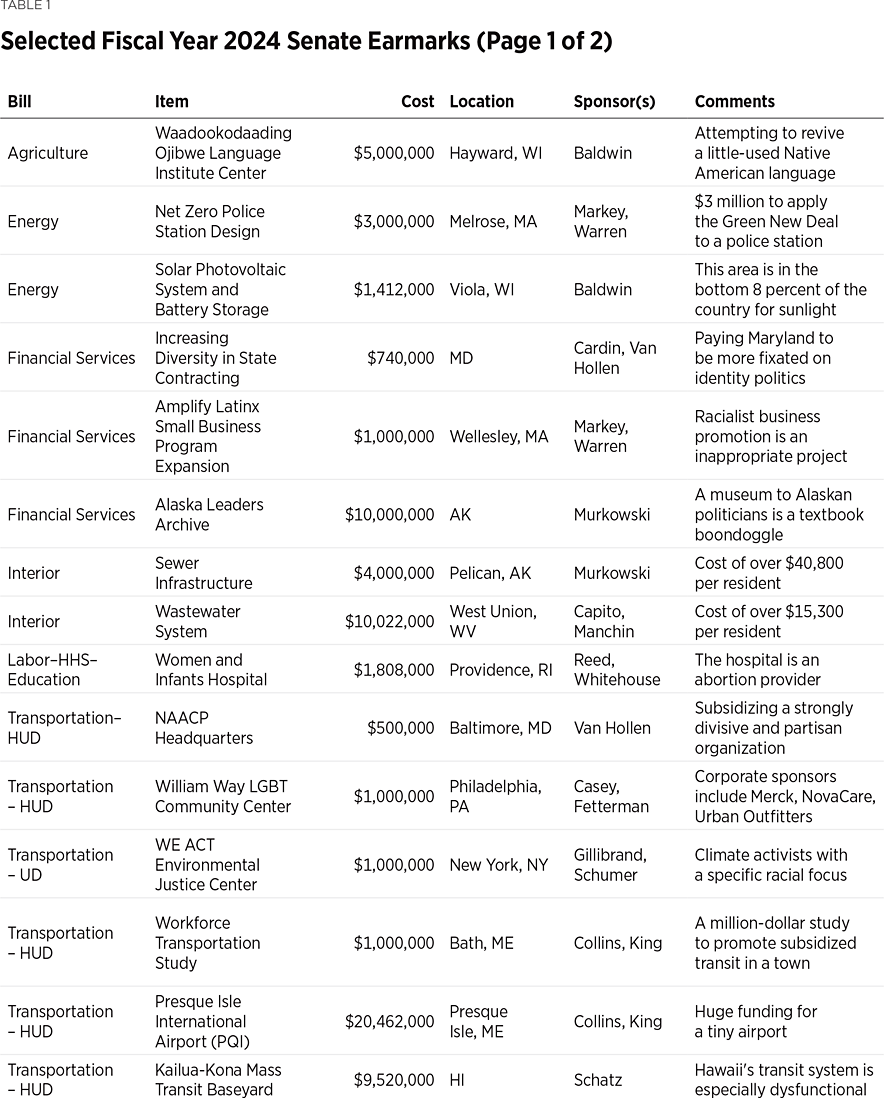
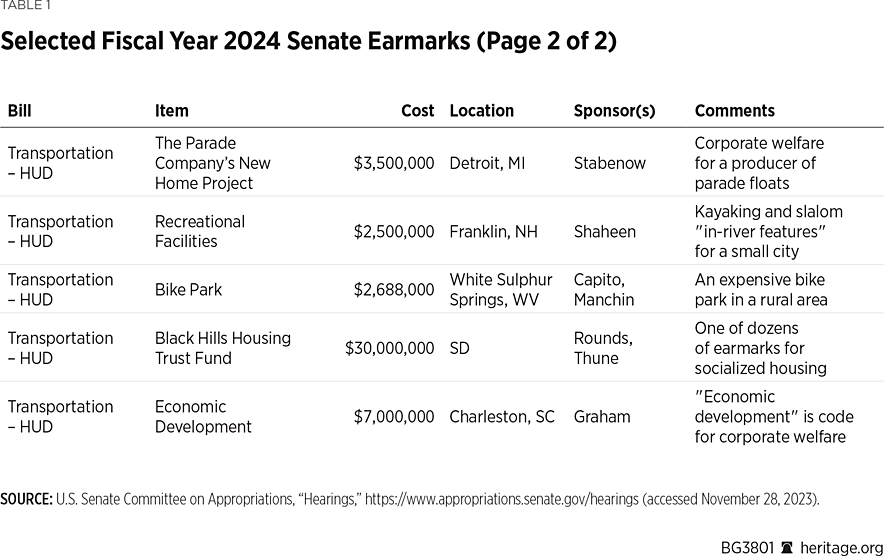
Earmarks and their related programs represent tens of billions of dollars in funding that uses the federal government as a highly inefficient pass-through for state and local governments. This arrangement has grown steadily both in absolute terms and as a share of the economy. As federal finances continue to deteriorate, there is no reasonable policy justification for the current set of intergovernmental subsidies.REF In contrast, the House Appropriations Committee’s spending bills made substantial progress in this regard, reducing intergovernmental transfers for education, welfare, and environmental activities.REF
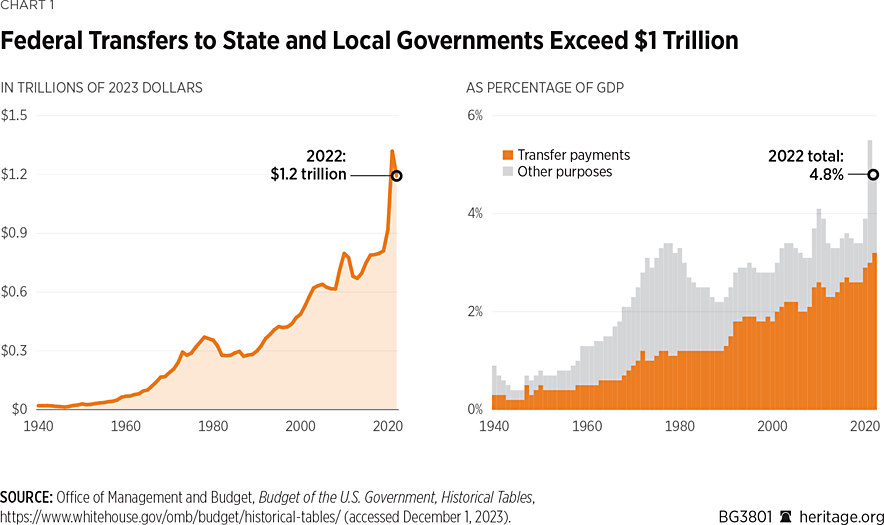
Comparisons to the House Appropriations Committee’s work are instructive in other areas as well. The House’s reduction of international “development assistance” is long overdue because such spending is often ineffective and unjustified at a time of high deficits.REF The House eliminates funding for the ineffective Job Corps,REF the duplicative Agency for Healthcare Research and Quality, and the wasteful National Endowments for the Arts and Humanities.REF Meanwhile, the Senate’s approach protects the federal leviathan rather than doing the necessary work of prioritizing federal activity in response to the changing fiscal environment.
Theoretically, the FRA should have forced Senate appropriators to perform a fair amount of prioritization by imposing a lower spending cap for FY 2024 compared to the FY 2023 omnibus package. Unfortunately, the FRA was bundled with shortcuts that allow the Senate’s big spenders to avoid having to make the kind of tough choices that most families contend with every day.
Fraudulent “Fiscal Responsibility”: $61 Billion in Budget Gimmicks
The FRA was the product of backroom agreements that were only partially leaked to the public. It was not until the Senate released the text of its appropriations bills that the full extent of the budgetary fudging became clear.
To begin with, the Senate’s bills include roughly $25 billion in illusory rescissions and spending limitations. Based on congressional accounting rules, such provisions lower the scored cost of a bill, creating room for other spending within the overall caps. In some cases, rescissions remove authorization from accounts and reduce outlays, meaning that there is a legitimate offset. In other cases, rescissions remove spending authorizations that would lead to little or no reduction in outlays. This means that when the “empty” authorization is rescinded and exchanged for a typical appropriation, the result is a net spending increase.REF
The Senate’s spending bills, which comply with the FRA agreement, feature a mix of genuine and false rescission offsets. The following is a partial review of the provisions in question:
- Commerce, Justice, Science. This contains a rescission of an $11 billion Nonrecurring Expenses Fund in the Department of Commerce, which was created by the FRA for the express purpose of being rescinded. The CBO estimated that the provision (if left untouched) would produce negligible outlays, meaning that it would lead to a net spending increase of just under $11 billion.REF This is the height of budgetary chicanery, and the FRA repeats the $11 billion fraud in FY 2025. In addition, the subcommittee bill contains a “limitation” on spending by the Crime Victims’ Fund, which is a perennial budget gimmick whereby unspent dollars in the fund are counted as savings. Since Congress has never rescinded the balance of the fund, the “savings” trick has been used for over a decade.REF
- Energy. There is a $401 million rescission of the Strategic Petroleum Reserve, which has been used as a budget gimmick and a feeble policy crutch since 1975.REF Congress should sell off the reserve and rescind its outstanding balance, but this should be done to reduce the deficit rather than to enable spending elsewhere.
- Financial Services. The bill includes a $10 billion rescission of funding for Internal Revenue Service (IRS) enforcement work demanded by the Inflation Reduction Act (IRA). This rescission would have been welcome in isolation.REF However, in the context of appropriations legislation, it is scored as an offset, meaning that it creates dollar-for-dollar room within the spending cap. The IRA was passed on a partisan basis through the budgetary reconciliation process. Accordingly, using IRA funding to offset appropriations spending would encourage future sessions of Congress to pass excessively large and untargeted reconciliation packages, which could then be used as de facto slush funds to undermine spending caps through rescissions.
- Interior. A $350 million rescission of Indian Health Service funding originally passed in the American Rescue Plan (ARP) presents the same problem that the IRS rescission presents.
- Labor, Health and Human Services, Education. A $1 billion rescission of a Commerce Department Nonrecurring Expenses Fund originally passed in 2008 repeats the debased budgetary approach embodied in the Commerce bill’s $11 billion iteration. There is also an $850 million rescission from COVID-19 spending in the ARP. Given that the pandemic has waned since the ARP’s passage, there is a strong likelihood that those funds would never become outlays, meaning this is a false offset.
In addition to rescissions, the Senate Appropriations Committee utilizes over $36 billion in emergency designations (which do not count against spending caps) to bolster funding in a variety of politically strategic areas.REF While there is a fig leaf of justification—the White House must first make an emergency funding request—it is difficult to imagine the Biden Administration not following Congress by issuing compatible emergency requests should these provisions go into effect.
Rather than focusing the funds entirely on responding to genuine natural disasters or national threats, the emergency designation is twisted beyond recognition in service to maintaining the status quo for long-standing programs and bureaus, as the following table demonstrates.
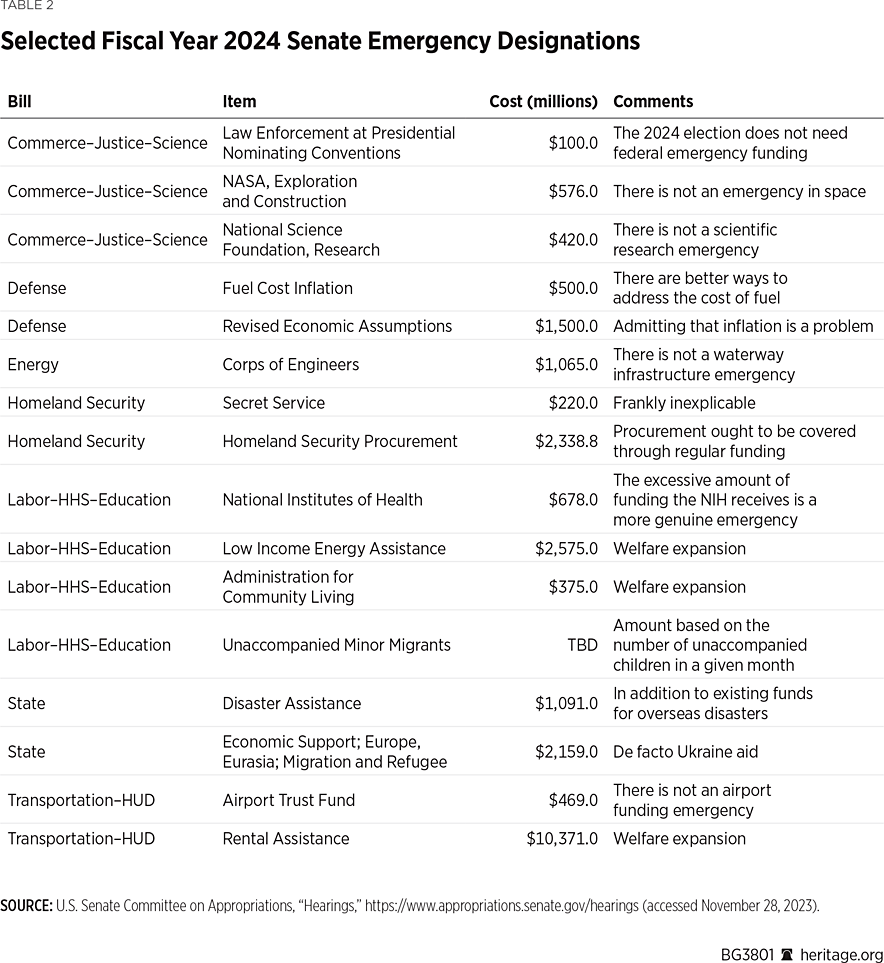
Attempting to hide funding for scientific research, waterway infrastructure, welfare programs, and federal agency procurement and construction expenses behind emergency spending designations is a severe abuse of what few congressional budgetary norms remain in effect. The purpose of such maneuvering is to pretend that the federal government is making sacrifices as part of the fight against inflation while still feeding the bureaucratic behemoth its usual diet of deficit spending.
The following table shows the real amount of spending in the Senate’s appropriations bills after accounting for adjustments.
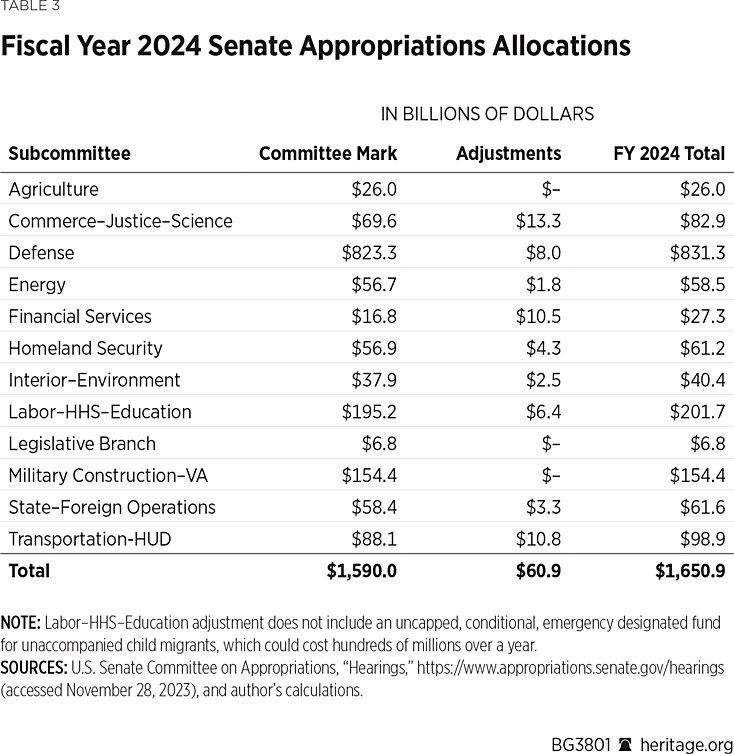
By using obscure budgetary maneuvers and widely distributing earmark project funding, Senate spenders have stacked the deck in their own favor. However, the only way for FY 2024 appropriations to achieve final passage is for the two chambers to reach an agreement, which means that fiscally responsible Members have significant leverage.
Conclusion
It is vital that Congress reject the dishonest approach to appropriating that is embodied in the FRA agreement. That not only means moving away from the Senate’s deeply flawed bills, but also improving the House legislation, which contains many of the same budgetary gimmicks that the Senate legislation contains.REF If that can be corrected, the prudent reductions and net spending cuts embodied in the House approach should be the template for any final legislation.
Critics claim that it is unrealistic to expect meaningful legislative deficit reduction when Democrats control the Senate and the executive branch, but this does not change the reality of the nation’s dire fiscal circumstances, which are turning into an economic perfect storm. Hardworking American families priced out of homeownership and global investors who question whether U.S. debt is a truly risk-free asset are watching how Washington responds to the current challenge. Legislators who choose to ignore reality do so at the nation’s peril.
David Ditch is a Senior Policy Analyst in the Grover M. Hermann Center for the Federal Budget at The Heritage Foundation.

